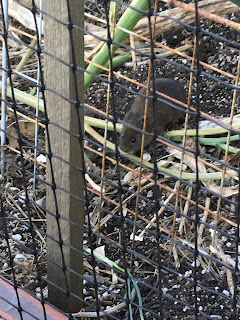Exciting projects are happening at our Ft. Scott Community Garden! It only took one year, but the greenhouse is finally functional- there is a floor, benches, a door, and the inaugural flats of seeds are inside. We're growing seedlings for our PresidioGrown beds- plots where we are growing vegetables that Presidio Foods uses at The Golden Gate Club and The Commissary, and for veggies to support our Trust and Nursery volunteer programs. But we're also growing seedlings in the hope we'll have more to share with you! The garden resource days on the second Saturday of each month will be great times for you to come visit us at the Ft. Scott Garden and grab some compost, mulch, and (fingers crossed) a few veggie seedlings. The calendar at the bottom of the blog is your go-to to find out when free resources will be available in 2018.
Taylor has also begun work on her independent project. She led a team of fellow interns to start clearing out the overgrown herb garden, salvaging plants, and getting ready to install an improved pollinator and herb garden this spring. Interested in helping her out? We can always use volunteers- get in touch! Below is her latest post on winter gardening tasks:
Hello Presidio community gardeners,
I thought that it might be helpful and relevant to write a
blog post about winter gardening in the Presidio. So here it is!
I think it’s important to mention that although we do have a
winter growing season here in San Francisco, there are few crops that actually
do well in this weather. That being said, I would emphasize the importance of
planning for the year ahead while you have little maintenance work to do in
your garden. Planning for the year ahead requires only a bit of effort on your
part but can make a huge difference in your spring and summer crop yields. Below
is a checklist of actions you can take to ensure that your garden will thrive
in the New Year!
(1)
Remove summer and fall vegetables (if you
haven’t already). And give your garden a good weeding- it’s always better to
get the weeds while they’re still small. Removing dying plants/debris from your
bed helps to prevent unwelcome pests from making a home in your garden during
the winter months.
(2)
Cultivate and amend your soil! If you planted
tomatoes or squash during the summer/fall and are just pulling the plants now,
chances are your soil needs amending. Heavy feeders like tomatoes and squash
need a lot of nutrients in order to produce their fruits. Breaking up the top
few inches of your bed’s soil with a shovel and then adding compost will help
to rebuild the health of your soil.
(3)
Think about what cool season crops will thrive
in your garden. Despite the chill in the air, there are a few crops that do
well this time of year. Peas, leeks, fava beans, garlic, and greens (kale,
lettuce, spinach, and chard) are all great vegetables for you to rotate into
your garden for the winter season. Try growing a neutral or light feeder (like
peas or fava beans) to ensure that your bed’s soil will not need further
amending before the heavy planting that comes in early spring.
(4)
Ensure that your cool season crops have the
tools they need to succeed! If you are planting peas or fava beans it is
important for your garden to have a structure for these plants to climb! Also,
small seedlings and transplants need a bit of help in this cold weather. Using
the top half of a soda bottle or milk jug as a mini greenhouse for your plants
will help them to thrive despite the cold weather.
(5)
Establish a planting plan for the New Year.
Think about what you would like to try planting in your bed in 2018. Consult
with a relevant planting calendar (planting calendars for San Francisco can be
found online, in previous blog posts, and in your gardener orientation packet).
When establishing a planting plan, take into account the importance of rotating
your crops from year to year. Crop rotation can help with soil health and can
also help with avoiding long term pests.
I’ll write another blog post to further explain crop
rotation in the New Year (before the early spring season starts). Until then,
happy holidays, happy growing!
-Taylor J































